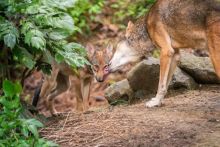
Did you know that eastern North Carolina is the only place in the world where endangered Red Wolves are found in the wild?
Currently, there are 18 radio-collared Red Wolves found in Alligator River National Wildlife Refuge, Pocosin Lakes National Wildlife Refuge and on private lands, with possibly another six young pups that have yet to be collared.
Photo from Red Wolf Coalition Facebook
Red Wolves became endangered due to intensive predator control programs and habitat degradation in the early to mid-20th century. Up until then, Red Wolves were thriving in the Eastern and Southern United States, but by 1967 they were listed under the Endangered Species Preservation Act.
The U.S. Fish and Wildlife Service (USFWS) then made efforts to conserve and recover the species. In 1972 USFWS captured the last of the wild Red Wolves, then found in southeast Texas and southwest Louisiana, to begin a captive breeding program to save the species. In 1987 they introduced four breeding pairs into the wild at Alligator River National Wildlife Refuge, and more wolves were added later. The wild population of Red Wolves reached 120 by 2012, but in 2015, USFWS stopped reintroducing red wolves to the wild. By 2020 the population of wild Red Wolves had dropped to only seven in the world.
Thanks to renewed protection efforts, today there are 18 wild Red Wolves in eastern North Carolina, and approximately 241 red wolves are maintained under human care within the SAFE (Saving Animals From Extinction) program facilities throughout the United States.
Because there are so few Red Wolves in the wild, and because they are shy, elusive animals who have no interest in human activity, red wolves are not commonly seen out in the open on the refuges. When they are seen, it is usually at dusk or dawn.
The Red Wolves look similar to coyotes but they are bigger, with longer legs and tall pointed ears, and weighing from 45 to 80 pounds as adults. The wolves are brown or buff colored, and their signature reddish color is typically on their ears, head and legs.
According to USFWS, Red Wolves feast on white-tailed deer, raccoons and smaller mammals like rabbits, rodents and nutria. They will travel up to 20 miles a day or more to find food. They are social animals who live in family packs and tend to form pair bonds for life. They mate once a year in February, and pups are typically born in April or May. Unfortunately, only about half of wild Red Wolf pups survive to adulthood due to disease, malnutrition, predation and vehicle strikes.
You can learn more a lot more about Red Wolves on USFWS's Red Wolf webpage.
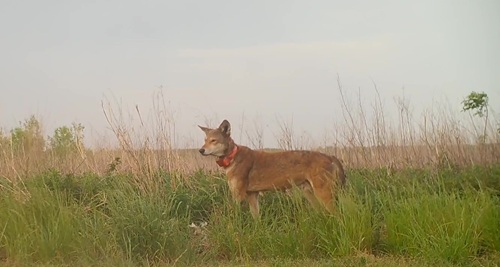
A collared red wolf in the wild. Photo from Red Wolf Recovery Program (1) Facebook
Watch for Red Wolves When Driving Highways 64, 264 and 94
Cassia Rivera, a wildlife conservationist, filmmaker and founder of N.C. Wildlife Corridor, is a passionate supporter of eastern North Carolina’s wild Red Wolves. Her documentary film, Right of Passage, made with teammates Nancy Arehart and Jennifer Hadley, advocates for Red Wolf safety in eastern North Carolina. You can watch the fillm here.
“The number one threat to critically endangered wolves is vehicle strikes,” Rivera says. “Red Wolves should be able to cross into new territory without the fear of vehicle strikes.”
To this end, Rivera is working with USFWS to educate the public about driving on highways 64, 264 and 94 in eastern North Carolina – the roadways where several red wolves have been hit by vehicles. Highway 64 is the highly traveled primary point of access to the Outer Banks from the west, and drivers are strongly urged to stay alert for red wolves along this road. With such a small population of wild red wolves and with the survival rate of pups at only around 50%, the world cannot afford to lose even one red wolf to a vehicle strike.
One way the U.S. Fish & Wildlife Red Wolf Program is working to reduce vehicle strikes in the eastern N.C. counties of Dare, Hyde, Tyrrell, Washington and Beaufort is through signage along the highways.
Mobile signs along the highways raise awareness about the possibility of red wolf crossings. Rivera says they have been helpful for raising awareness about the presence of red wolves in the area. And, because they are mobile, the signs can be moved based on GPS signals of where the wolves are located at any given time.
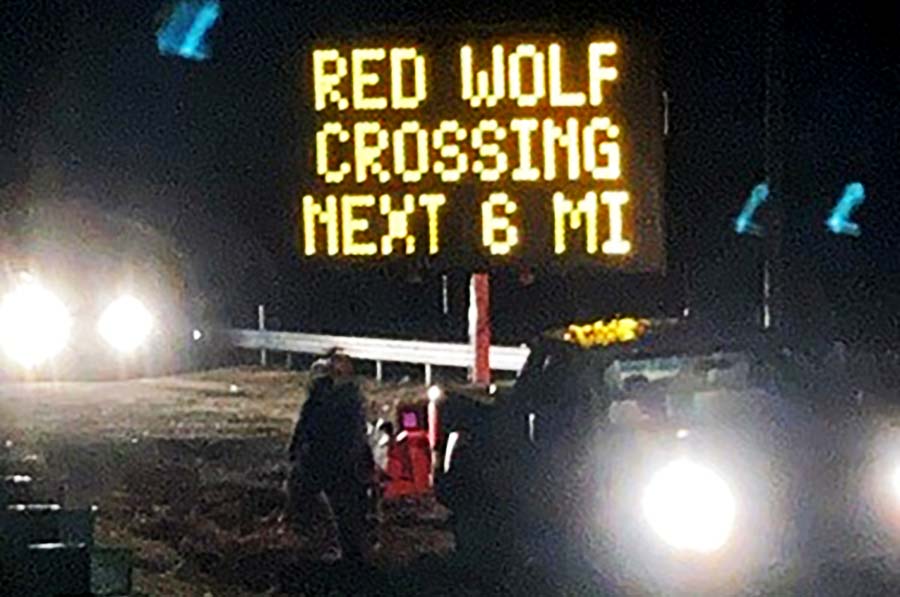
Signs along inland highways alert drivers to look out for red wolves. Photo Conservation Conversations: Howling for Red Wolves - North Carolina Wildlife Federation
If traveling along highways 64, 264 or 94 in northeastern North Carolina, drivers are asked to:
Slow Down
One of the major issues with wildlife strikes is speeding through the long, remote stretches of highway on the way to the Outer Banks.
Don't Be Distracted
Distracted driving (most specifically texting and using your phone) is also a major factor in accidents and wildlife strikes. Animals you might encounter along these highways include red wolves, deer or giant black bear, any of which could cause death to the animal and major damage to vehicles or life-threatening injuries to drivers and passengers.
Stay Alert
Be on the lookout for red wolves wearing a bright orange collar, which makes them easier to spot, and other wildlife.
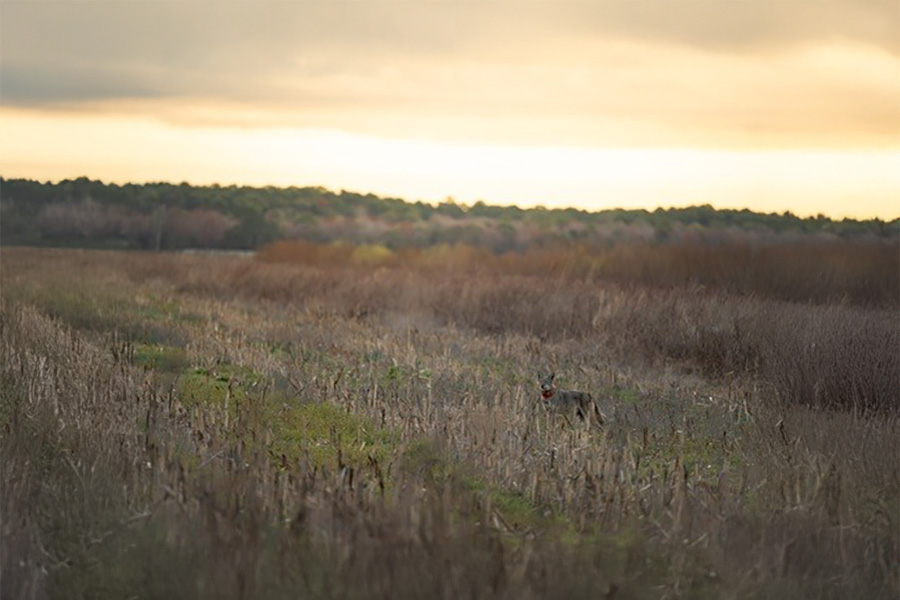
Photo by Cassia Rivera
Rivera is so committed to red Wolves that she recently paid for 2,000 USFWS pamphlets to help get the word out about Red Wolf vehicle strikes. You can see the pamphlets online here.
“As a photographer, I documented my first Red Wolf in field 10 years ago, and I won’t ever forget the majesty of that animal,” she says. “Red Wolves hold incredible value to me. I love them, my children love them. Supporting them has become a family affair, it’s really personal to us.”
Learn about the Wildlife Crossing Pilot Program
Another way biologists and conservation organizations hope to protect Red Wolves and other species is with wildlife underpasses beneath U.S. Highway 64. And in a boon for Red Wolves and all sorts of wildlife species in the refuges, in December 2024 the Federal Highway Administration awarded N.C. Department of Transportation a $25 million grant for its Wildlife Crossing Pilot Program. This grant will aid in the construction of multiple wildlife crossing underpasses in eastern North Carolina. The project is in research and development phases now, and tunnel construction will begin in 2026.
“This was a huge win for conservationists and Red Wolves,” Rivera says. “That’s one of the beautiful things about Red Wolves. They are an ambassador species that moved the decision makers.”
The underpasses will work with the help of fencing that helps funnel multiple species of wildlife, from bears to deer to wolves to reptiles and amphibians, into crossings under the road.
Support the Red Wolf Coalition
Another organization working to protect Red Wolves is the Red Wolf Coalition (RWC) in Columbia, North Carolina.
Founded in 1997, RWC is a hub of private support for long-term red wolf restoration and works with the USFWS Red Wolf Recovery Program to stay up to date on Red Wolf restoration and management issues and to partner in the effort to maintain healthy populations of wild Red Wolves. RWC hosts programs and a website and offers print information to educate the public about Red Wolves and their value to the ecosystem.
“First and foremost, we offer education and outreach and partner with and support the Fish and Wildlife Service,” says Kim Wheeler, RWC executive director.
Of late, RWC has helped fund coyote sterilization to prevent crossbreeding with Red Wolves and funded a highway sign and a Red Wolf acclimation pen.
You can volunteer or donate to the RWC here.
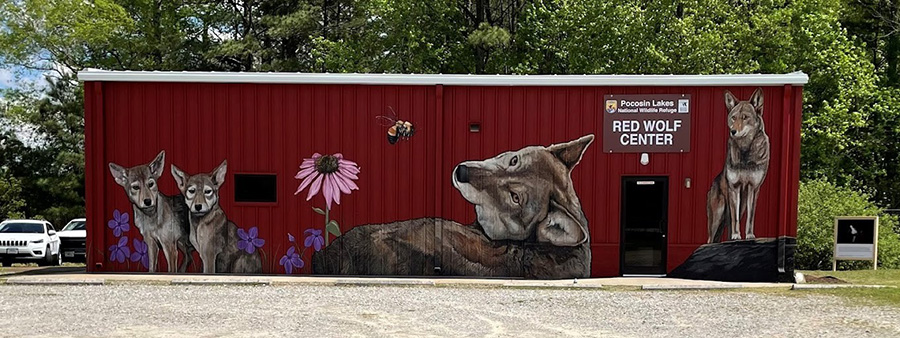
A mural of red wolves graces the exterior of the Red Wolf Center at Pocosin Lakes National Wildlife Refuge. Photo: Jennifer Koches/USFWS
Visit the Red Wolf Center in Columbia
Learning about endangered Red Wolves will inspire you to protect them. If you’re curious about red wolves, the best place to go is the Red Wolf Center in Columbia, about an hour’s drive west of the Outer Banks. Located on Highway 94 in Pocosin Lakes National Wildlife Refuge, the center has a small reception area and offers educational programs and information on the Red Wolves. Visitors can even view a pair of captive Red Wolves up close – a 3-year-old male and a 7-year-old female, who, it is hoped, will breed pups next year. The exhibit wolves cannot be released back into the wild due to injuries or other reasons. Part of the center is used by USFWS biologists to safely handle wild Red Wolves in need of medical care.
For directions to the center and hours of operation, call (252) 796-3004 or visit Pocosin Lakes National Wildlife Refuge | Visit Us - Locations | U.S. Fish & Wildlife Service | FWS.gov
Visit the National Wildlife Refuges
Visiting Alligator River National Wildlife Refuge or Pocosin Lakes National Wildlife Refuge will inspire you to take care of Red Wolf habitat – and if you are really lucky, you just might see a rare Red Wolf in the wild. If that happens to you, share your photos and report any unusual sightings.
Take Photos Responsibly
If you do spot a Red Wolf, be sure to take your photos responsibly. Photos can help biologists in their outreach and are also a good way for them to assess the health of individuals and determine pairings. However, please keep in mind that the enthusiasm of seeing or photographing a rare species can put them at risk. Keeping a minimum of 100 yards from Red Wolves helps keep them wild. Never pursue Red Wolves for up-close photos. Do not remain near the animal for a long time, as your presence may disrupt their normal behavior.
Report Unusual Activity
Please report any suspected or unusual sightings, an injured or dead Red Wolf, or any suspicious behavior to the Red Wolf Hotline at the number or e-mail address provided below.
Red Wolf Hotline: 1-855-4WOLVES


 Molly Harrison is managing editor at OneBoat, publisher of OuterBanksThisWeek.com. She moved to Nags Head in 1994 and since then has made her living writing articles and creating publications about the people, places and culture of the Outer Banks.
Molly Harrison is managing editor at OneBoat, publisher of OuterBanksThisWeek.com. She moved to Nags Head in 1994 and since then has made her living writing articles and creating publications about the people, places and culture of the Outer Banks.

